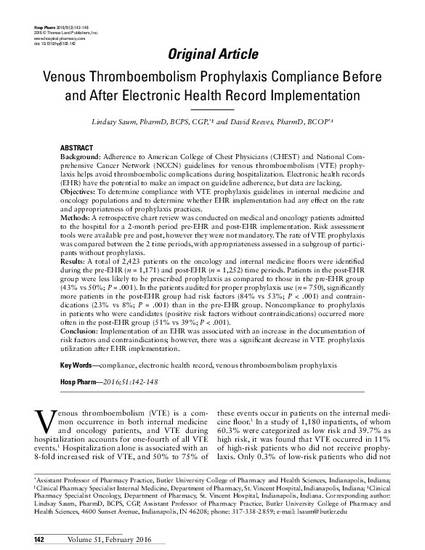
Background: Adherence to American College of Chest Physicians (CHEST) and National Comprehensive Cancer Network (NCCN) guidelines for venous thromboembolism (VTE) prophylaxis helps avoid thromboembolic complications during hospitalization. Electronic health records (EHR) have the potential to make an impact on guideline adherence, but data are lacking.
Objectives: To determine compliance with VTE prophylaxis guidelines in internal medicine and oncology populations and to determine whether EHR implementation had any effect on the rate and appropriateness of prophylaxis practices.
Methods: A retrospective chart review was conducted on medical and oncology patients admitted to the hospital for a 2-month period pre-EHR and post-EHR implementation. Risk assessment tools were available pre and post, however they were not mandatory. The rate of VTE prophylaxis was compared between the 2 time periods, with appropriateness assessed in a subgroup of participants without prophylaxis.
Results: A total of 2,423 patients on the oncology and internal medicine floors were identified during the pre-EHR (n = 1,171) and post-EHR (n = 1,252) time periods. Patients in the post-EHR group were less likely to be prescribed prophylaxis as compared to those in the pre-EHR group (43% vs 50%; P = .001). In the patients audited for proper prophylaxis use (n = 750), significantly more patients in the post-EHR group had risk factors (84% vs 53%; P < .001) and contraindications (23% vs 8%; P = .001) than in the pre-EHR group. Noncompliance to prophylaxis in patients who were candidates (positive risk factors without contraindications) occurred more often in the post-EHR group (51% vs 39%; P < .001).
Conclusion: Implementation of an EHR was associated with an increase in the documentation of risk factors and contraindications; however, there was a significant decrease in VTE prophylaxis utilization after EHR implementation.
This article was archived with permission from Thomas Land Publishers, Inc., all rights reserved. Document also available from Hospital Pharmacy.
Available at: http://works.bepress.com/david-reeves/15/
